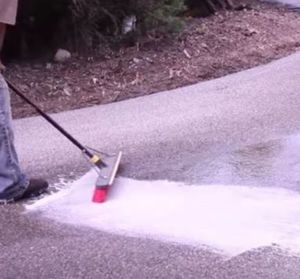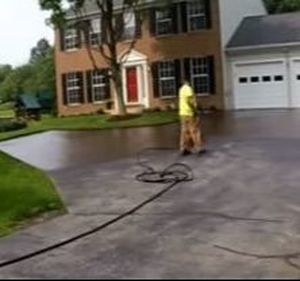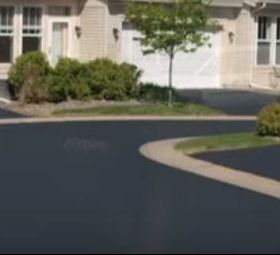Asphalt-Driveway-Crack-Repair-Resurfacing-Sealcoating-
and-Potholes-Cost Services in New Brunswick, Trenton and Hunterdon County in New Jersey
Blacktop Driveway Repair
- Asphalt driveway deterioration as it ages is a given but knowing the type, cause and extent of the distress will signify what type of repairs are needed for the best long-lasting solution. Preforming maintenance repair when asphalt pavement faults first appear is a budget friendly response to driveway repairs because if you wait costs only go up as the damage widens.
- Ageing pavement faults include: cracking, oxidation, ponding problems and potholes. As pavement ages, it loses flexibility becoming light grey as the binder is lost to oxidation. Loss of flexibility will cause the pavement to devolve into severe cracking as cars travel across its surface. Soon these cracks will turn into crumbling pavement, then potholes and finally just a muddy mess unsafe to drive cars across let alone safe for people to cross on foot.
Residential Asphalt Driveway Crack Repair
- Fatigue (Alligator Cracking) possible causes are excessive loading, such as too heavy trucks or campers parked on the driveway, weak asphalt mix, base (subgrade) and poor drainage. A lasting fix should remove all cracked pavement, repair the subbase and finally repave.
- Block Cracking probable cause pertains to the asphalt mix that was laid, during installation, it used binder that was too old or dried out- just a poor substandard asphalt mix. Crack seal fill of the block cracking will stop moisture from infiltrating the base and causing further damage.
- Edge Cracks show lack of lateral or edge support caused by settlement of underlying material, shrinkage of drying soil, weak base or subgrade layer, poor drainage, heavy traffic and vegetation along edge. Depending on how badly the edging is cracked, repair will either require asphalt emulsion spread along the edge to fill the cracks or the edging may have to be removed and replaced with stronger support before repaving.
- Reflection Cracking will occur when an asphalt overlay is place over severally damage pavement that has not been repaired. The damage pavement will reflect up through the new pavement in short order making the expensive overlay rather useless. Long lasting repairs may require removal of the damaged asphalt and, if needed, in depth repairs to the underlying subbase then repaving the asphalt surface can take place.
- Upheaval of pavement is caused when water logged soil underneath the driveway pavement swells into ice crystals pushing up and cracking its surface. Tree roots (or even weeds) can also cause upheaval pavement damage when their roots grow under the driveway. The underlying cause of drainage problems need to be fix then the pavement can be resurfaced when a long-term solution is desired. Trees with invasive roots traveling under the driveway need to be removed completely (roots and all) before the driveway can be repaved.
Costs to Repair Asphalt Driveway Cracks
- The cost to repair a crack depends on its severity, how many cracks there are and what type of repair is suggested or desired:
- A cold patch (previously mixed asphalt) is the least expensive because it is the quickest and simplest type of repair to make. Though, it is most often a temporary solution, such as when the weather is too cold for a hot patch. A cold patch can simply be packed into the crack- no preparations necessary.
- Hot patching is a more complicated process as the crack needs to be blown out of all loose material including removing crumbling asphalt surrounding the crack only then can the hot asphalt be packed in the crack and compacted across the asphalt surface.
- Infrared Repair is used to make a more seamless repair because the infrared lighting heats the damaged surface to a molten asphalt which helps to restore as well as any additional asphalt patching mix used to smooth out any remaining blemishes. Settling of the asphalt patch on the driveways surface, which can happen with other repair methods, is less likely.
- Hiring a professional, like Jersey Strong Paving, who will figure out what caused the crack or cracks and then implement a long-lasting fix.- this is by far the most economical path to take.
Homeowners Driveway Pothole Repairs
- Pothole repairs Sealing cracks in a pavement is the most important step in preventing potholes. Potholes are caused by water that has infiltrated though cracks into the subbase and when the weather turns cold the water will freeze expanding and then contracting once the weather warms. This expansion and contraction of ground water within the subbase will cause severe movement of the pavement only worsening with time. This movement destabilizes that section of the subbase under the asphalt driveway. Then, coupled with continued movement of car traffic overhead the pavement will break off into chunks, as the car tires roll over, ejecting both the asphalt and gravel subbase till eventually a large pothole is formed.
- Long-lasting Pothole repair begins with all deteriorated material removed from the Pothole, the hole squared off to straight vertical sides and then using high pressure air all the dust of the crumbling pavement or other debris is blown free of the hole. Sometimes, some of the subgrade needs to be removed to reach firm support but whatever is removed is replaced and compacted. Once the hole is cleared of all loose material, a tack coat adhesive is applied throughout the hole. Finally, an asphalt mix, specific for patching holes, is filled into the hole then compacted with a roller. Jersey Strong Paving guarantee all repairs.
Residential Asphalt Driveway Resurfacing
- Resurfacing, or overlay, is a way of repairing an existing asphalt driveway by removing the top few inches of asphalt and paving overtop of it. There are certain preparations for constructing an overlay, which include milling, or shaving a few inches off the original pavement while at the same time leveling the surface so that the new asphalt layers, after compaction, will meet with the existing garage apron and sidewalk. Areas that are in very poor condition, meaning alligator pavement, must be removed and patched or the cracking will shortly reflect back up through the overlay. After the driveway has been milled or shaved and leveled, the driveway is cleaned, an adhesive is laid down, and then the new asphalt is applied in compacted layers.
- Milling is when part of the surface of a paved area is removed and ground up to be used as the aggregate in the new pavement. Just enough of the surface is removed to correct the uneven driveway and allow for new asphalt layers to be installed. This process is responsible for recycling about 95% of old asphalt pavement that is to be resurfaced.
- Shaving a process that uses a series of diamond tipped saw blades mounted on a rolling shaft that shave off the upper surface of an asphalt pavement and at the same time level the driveway to prepare for a new layer of asphalt pavement.
- Overlaying is less expensive than fully reconstructing a paved surface, and typically takes less time making it a great option when making asphalt driveway repairs for families that rely on their driveway for convenient parking. However, the areas that now puddle will again puddle since in most cases, the grade cannot be alter by just paving an overlay. Life expectancy for an overlay or resurfaced parking lot is 8-10 years if properly maintained.
- If you want to find out if asphalt resurfacing is right for your failing driveway, please contact Jersey Strong Paving and we'll be happy to give you a free estimate and let you know if other types of repairs might be best for your paving needs, such as patching among others.
When is Asphalt Driveway Resurfacing Suggested?
- Resurfacing is an affordable option that will benefit the homeowner with a like new appearing driveway without having to tear the whole thing out enabling the homeowner to improve the curb appeal which is important when selling your home. This process is also suggested for driveways that are oxidized (light grey in color) and have some cracking and pitting- yet the driveway still has a strong and solid subbase.
- If you want to find out if asphalt resurfacing is right for your failing driveway, please contact Jersey Strong Paving and we'll be happy to give you a free estimate and let you know what would work best for your paving needs.
Cost to Resurface an Asphalt Driveway
- Many factors will determine how much resurfacing an asphalt driveway will cost, such as size of driveway, how many in-depth repairs have to be made first, how many transitions (garage apron, sidewalk) and quality of asphalt mix. Also, adding to the cost would be any edge finishing like beveling or decorative stamping a pattern into the driveway.
- You will not find another asphalt paver who will service your driveway the way the industry suggests cheaper than we will. Our estimates cover repair of damaged subbase and high-quality asphalt. Cutting corners by using the asphalt mix of the day at the plant, which may be more suitable for nature paths or not laying the correct depth of asphalt layer is not something we do.
- Give us the opportunity to show how affordable it is to preserve the value and appeal of your property with a free, no commitments driveway inspection. Contact Jersey Strong Paving, as well as other paving contractors, you'll soon see we offer quality work at outstanding prices.
What is Asphalt and Why does it Need Sealcoating?
- Asphalt, also referred to as liquid asphalt, asphalt cement or asphalt binder is a remarkably durable paving component that has been in use for centuries. Natural tar pits are found by the hundreds across California. Native American Indians used tar to waterproof their boats and early settlers used it to waterproof their roofs or as mortar in building construction. Modern production of asphalt binder is a byproduct of oil refinery which is why the price fluctuates with the oil market.
- Asphalt pavement is subject to oxidation- loss of binder that happens with exposure to Sun and atmosphere. UV-Rays fuse with Oxygen electrons within the asphalt breaking its chemical bonds and causing brittleness. The best way to slow the process, down to a crawl, is through periodic application of Sealers.
What is a Sealcoat?
- A sealcoat contains anti-oxidation additives to provide a shield against the elements, sun, heat, rain, sleet, snow and wind. It will also seal the small cracks in your driveway’s pavement that can turn into large cracks. Sealing cracks prevents moisture passing through the pavement layer into the base. Moisture in the subbase causes the pavement to deteriorate faster as voids under the pavement fill with water and turn to ice as the weather turns cold. Ice crystals in the pavements subbase expands the soil causing a surface upheaval or pavement breakup.
- There are several types of Sealants to choose from that are designed for particular situations. Which sealant will work best for the condition of your driveway and in your environment can be advised by an experienced local Asphalt Contractor like Jersey Strong Paving.
Common Types of Sealants
- Coal Tar Sealer, a long-established sealer, easily obtained because it is a byproduct of petroleum refinement, however the smell released by its fumes (worse when applying in direct sunlight) can cause some people to be sick as well as skin irritation. These noxious fumes continue until cured so rarely will it be applied by non-professionals. Many homeowners still request coal tar sealer because it’s well know for its affordability, tough coat, deep black color and increased chemical resistance.
- Acrylic Sealcoats do not contain petroleum by-products which makes them less smelly and more environmentally friendly. They are derived from polymers and acrylic which does make them expensive but they provide longer periods of protection (years longer). They also come in many colors, such as green for tennis courts. Finally, acrylic sealcoats are UV-ray resistant, and very durable under extreme weather conditions.
- Asphalt Sealer Emulsions are an asphalt cement mixture of emulsifying agents and water. The emulsifying agent will keep the droplets of asphalt cement separated within the water until applied to the driveway. When the mixture is sprayed or rolled onto the asphalt pavement, the water separates from the asphalt cement and evaporates leaving behind a deep black coat of protective asphalt cement. Asphalt Sealer Emulsions are not as strong smelling as the coal tar sealers making it easier to breath nearby.
- Professional Sealcoating is better than what the big-box stores offer for DIY (Do It Yourself). These off-the-shelf sealcoating products are designed to work across many environments and are not necessarily the best fit for your driveway. Many professional contractors offer application of commercial quality sealcoating products to protect and waterproof asphalt driveways best suited for specific needs.
Costs for Sealcoating a Driveway
- Many circumstances influence costs for sealcoating, such as how large the driveway is, how dirty it is (oil stains need to be removed), conditions of the driveway (are there obstacles that will make the sealant difficult to apply) and the type of Sealant used. Sealant will fix slight surface blemishes but deep cracks or pot holes will have to be fix in order to repair all issues and these repairs will add to the costs.
- We are a local, experienced and affordable asphalt contracting team that is eager to gain your trust by sending superior consultants to evaluate and estimate the application of sealant to your driveway. Connect with us today for more information.
For Information about Specialized Paving Basketball and Tennis Courts Paths Playgrounds Click Here!
For information on Asphalt Driveway Installation, Replacement & Removal Costs in New Brunswick
For information on Asphalt Driveway Installation, Replacement & Removal Costs in Trenton
For information on Asphalt Driveway Installation, Replacement & Removal Costs in Hunterdon County
Looking for an asphalt paving contractor outside of our area? Try NC Asphalt Paving for trusted paving services in North Carolina.














